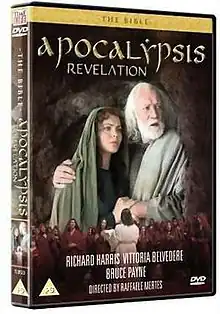The Apocalypse (2000 film)
Apocalypse or The Apocalypse (known in Australia as Revelation, the original title is San Giovanni – L'apocalisse)[1] is a biblical telefilm produced for European television[2] released in 2002 starring Richard Harris (in one of his final film roles)[3] and co-starring Bruce Payne.
| The Apocalypse | |
|---|---|
 | |
| Written by | Francesco Contaldo and Gianmario Pagano |
| Directed by | Raffaele Mertes |
| Starring | Richard Harris Bruce Payne |
| Country of origin | France Germany Italy United Kingdom |
| Original language | English |
| Production | |
| Running time | 96 minutes |
| Release | |
| Original release |
|
Plot
The film is set in 90 AD and concerns Jesus Christ's last surviving apostle, John, and his writings and visions from the Apocalypse of John. Emperor Domitian declares himself to be God and ruler over heaven and earth. The Christians do not recognize his divinity and face persecution from the God-Emperor. John has been banished to the island of Patmos, a Roman mining penal colony, with many others. The film follows Victorinus of Pettau's descriptions of the harsh conditions that John endured working in the mines on the island of Patmos.[4] He writes out messages of his visions and sends the "Revelation of God" to the seven churches of Greek Asia Minor. The Christian church in Ephesus sends Irene to make sure John is alive and to confer with him in person. The movie depicts scenes from the Book of Revelation and links them to events happening to the church in Asia.
Biblical scenes portrayed
- Revelation 1, Jesus among the Candlesticks
- Revelation 4, The Throne Scene
- Revelation 5, The Crisis of Sealed Scroll
- Revelation 6, The Seals Opened and Related Events
- Revelation 7, The Great Multitude
- Revelation 8, The Trumpets
- Revelation 12, The Woman, the Child and the Dragon
- Revelation 21–22, A New Heaven & A New Earth, Jesus Returns
Historical events portrayed
The movie Apocalypse includes these historical events:
- The Life and Reign of Domitian with his proclamation of divine status and persecution of Christians.
- Patmos as a penal colony
Apocalypse events mentioned in early Christian literature:
Eusebius, in Ecclesiastical History 3:18–20 [5]
- 3:17 – Domitian conducted a reign of terror
- 3:18–1 – During this time, John was exiled to Patmos.
- 3:18–3 – Irenaeus wrote that John lived during the reign of Domitian.
- 3:20–10 – Domitian died and Nerva took over. Nerva tried to undo some of the results of Domitian's cruelty.
- 3:20 – John returned to Ephesus at this time.
Cast
- Richard Harris as John the Apostle
- Vittoria Belvedere as Irene
- Benjamin Sadler as Valerius
- Christian Kohlund as Quintus Maximus, a general
- Erol Sander as Ionicus
- Ian Duncan as Demetrius
- Bruce Payne as Domitian
Production
The TV movie was the last of the many movies based on Bible stories produced by Lux Vide.[6] The films that Lux Vide had produced prior to it included Genesis: The Creation and the Flood, Jacob, Joseph, Moses, Samson and Delilah, David, Solomon, Jeremiah, Esther and Jesus.[7]
Reception
The TV movie received mixed reviews. Luisa Sandrone of Famiglia Cristiana wrote that Harris gave a "masterful performance" in the film.[8] Marcus Jäntsch of peplumania.com gave the film 3 out of 5 stars.[9] Peter T. Chattaway of patheos.com gave the film 2 out of 4 stars.[10]
References
- "The Apocalypse (TV Movie 2000) - IMDb" – via www.imdb.com.
- "The Apocalypse | TV Guide". TVGuide.com.
- Malone, Peter (2012). Screen Jesus: Portrayals of Christ in Television and Film. Plymouth: The Scarecrow Press. ISBN 9780810883901.
- Boxall, Ian (2013). Patmos in the Reception History of the Apocalypse. Oxford: Oxford University Press. ISBN 9780199674206.
- Eusebius Church History, Book III, Chapters 17–20 Accessed April 7, 2011
- "With "San Giovanni-L'Apocalisse" the ten-year Bible project of Rai Richard Harris, the last apostle, concludes. The story of the disciple played by the Irish actor". La Nuova. Retrieved 10 September 2020.
- "Productions". Lux Vide. Retrieved 10 September 2020.
- Sandrone, Luisa. "Television with the Apocalypse". Famiglia Cristiana. Retrieved 10 September 2020.
- "Antike im Film | Epics | Monumentalfilme | Sandalone | Bibelfilme | peplum | Sandalenfilm | Sword and Sandal : Filme".
- "Review: The Apocalypse (dir. Raffaele Mertes, 2002)". April 28, 2004.